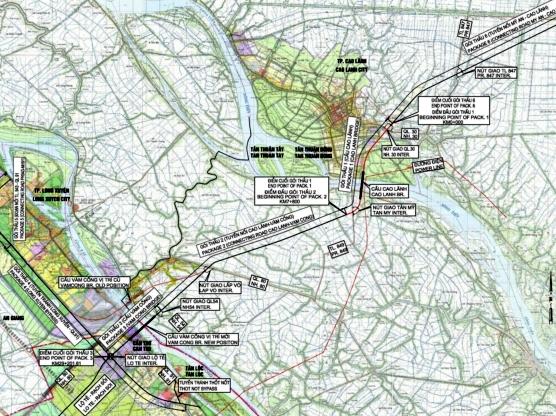 The project has been developed with the support of an Asian Development Bank (ADB) and Government of Australia (GOA) financed Project Preparation Technical Assistance (PPTA) grant.1 The purpose of the PPTA was to develop the project to a level suitable for ADB financing. The PPTA provided the resources required to prepare the project and identify adequate mitigation of the project’s social, resettlement, environmental, and other impacts. The PPTA also reviewed and updated feasibility studies that the Government of Viet Nam’s (the Government) Ministry of Transport (MOT) and …
The project has been developed with the support of an Asian Development Bank (ADB) and Government of Australia (GOA) financed Project Preparation Technical Assistance (PPTA) grant.1 The purpose of the PPTA was to develop the project to a level suitable for ADB financing. The PPTA provided the resources required to prepare the project and identify adequate mitigation of the project’s social, resettlement, environmental, and other impacts. The PPTA also reviewed and updated feasibility studies that the Government of Viet Nam’s (the Government) Ministry of Transport (MOT) and …
Full name of Project: Central Mekong Delta Region Connectivity Technical Assistance Project Delegated TA 40255-04 – VIE
(Detailed Design, procurement and Implementation Support Services)

1. The Central Mekong Delta Connectivity Project (CMDCP) will construct the portion of Viet Nam’s proposed Second Southern Highway that traverses the Mekong Delta region to the west of Ho Chi Minh City (see map at Attachment 1). The project consists of three components:
(i) The Cao Lanh bridge, a cable stayed structure about 2 km long and 6 lanes wide over a branch of the Mekong River, with a central span of 350m and a maximum height above high water level of 37.5m;
(ii) A connecting road between the two bridges about 16 km long, designed to 6 lane expressway standard and constructed initially to 4 lanes;
(iii) The Vam Cong Bridge, similar to the Cao Lanh bridge, with a central span of 450m (consisting of Component 3A, the bridge itself, and Component 3B, the bridge approaches).
2. The project has been developed with the support of an Asian Development Bank (ADB) and Government of Australia (GOA) financed Project Preparation Technical Assistance (PPTA) grant.1 The purpose of the PPTA was to develop the project to a level suitable for ADB financing. The PPTA provided the resources required to prepare the project and identify adequate mitigation of the project’s social, resettlement, environmental, and other impacts. The PPTA also reviewed and updated feasibility studies that the Government of Viet Nam’s (the Government) Ministry of Transport (MOT) and its CUU LONG Corporation for Investment, Development and Project Management of Infrastructure (Cuu Long CIPM) had prepared for the project. The PPTA found the project to be financially and economically feasible, with social and environmental impacts that could be effectively mitigated.2
3. Based on the PPTA study, the estimated cost of the project is about US$750 million. The Government has requested financing assistance for the project from ADB, the GOA, and the Government of Korea (GOK). When completed, the project will be operated as a toll road, with tolls set to recover at least operation and maintenance costs.
4. As part of the overall project financing, the Government has requested ADB to provide support for the detailed design and implementation support for Components 1 and 2 and possibly a portion of Component 3 (Component 3B: the road approaches to the Vam Cong Bridge) as a package. The GOA, through the Australian Agency for International Development (AusAID), is considering providing financing for these activities. The major portion of Component 3 (Component 3A: the Vam Cong Bridge including approach structures), for which the GOK has indicated it may provide financing, will be designed and supervised separately.
5. The detailed design and implementation support, the latter to include construction supervision, will be undertaken by a single consulting firm, which may be a consortium of firms, hereinafter referred to as the consultant, through a single contract. The consultant will be selected by ADB, in consultation with CUU LONG CIPM, and contracted by CUU LONG CIPM. Separately, ADB will select and CUU LONG CIPM will engage a Proof Check Consultant to undertake an independent check of all aspects of the Cao Lanh bridge designs prepared by the consultant. The consultant will be required to facilitate the proof checking process, by providing access to premises, documents, design information and other necessary services.
6. The contract between CUU LONG CIPM and the consultant will consist of two parts, the first for detailed design, and procurement support to the point at which civil works contracts have been finalised and are ready for signature, and the second for implementation support, including supervision of the civil works contracts and other implementation-related activities. The second part will be subject to a second notice to commence, which will be dependent on the consultant’s performance under the first part, and also on each of the project’s financiers confirming its financing for the project’s implementation.





